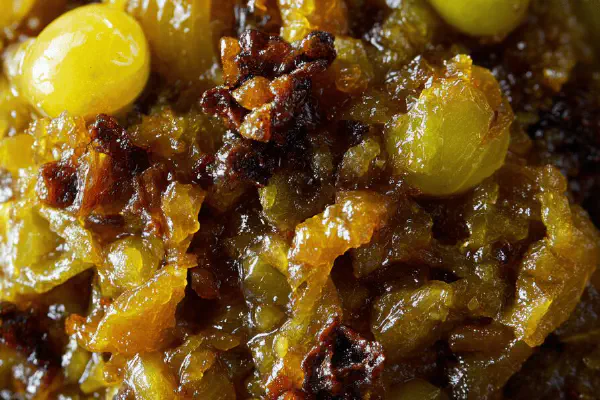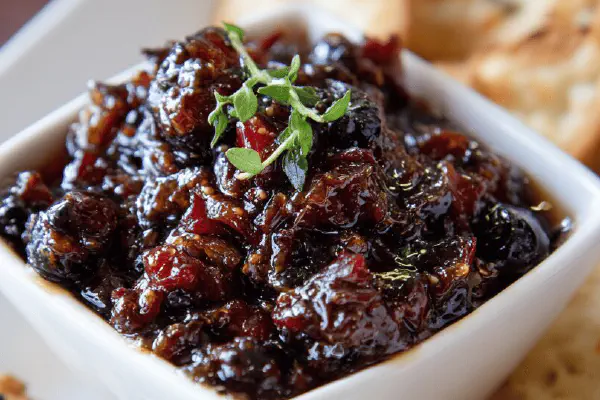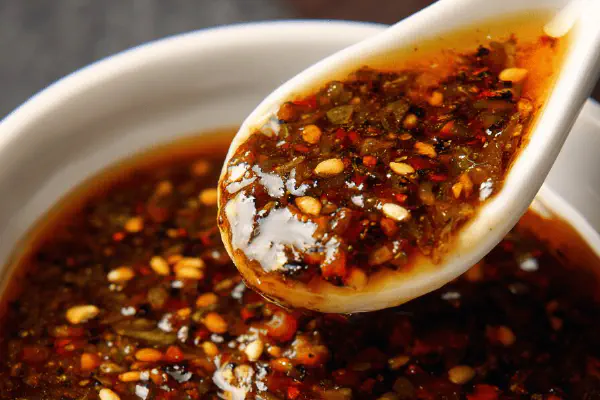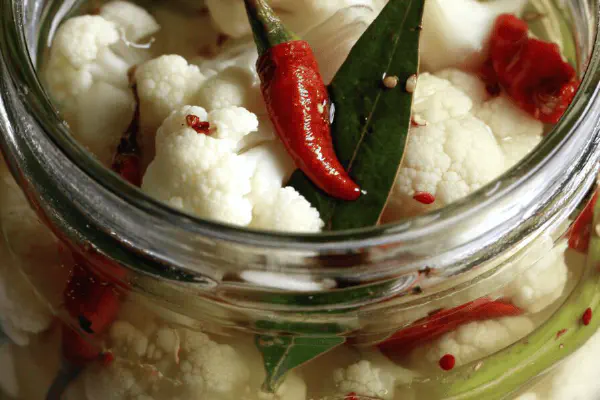Ginger Grape Chutney

By Emma
Certified Culinary Professional
Ingredients
- 320 g (about 2 cups) fresh green grapes halved
- 35 g (1/4 cup) golden raisins
- 25 ml (1 1/2 tbsp) diced candied ginger
- 25 ml (1 1/2 tbsp) apple cider vinegar
- 1 small shallot, finely chopped
- 0.5 ml (1/8 tsp) ground cinnamon
- 0.5 ml (1/8 tsp) smoked paprika
- 12 ml (2 1/2 tsp) arrowroot powder
- 35 ml (2 1/3 tbsp) cold water
- Salt and freshly ground black pepper to taste
About the ingredients
Method
- Start by heating a medium saucepan over medium heat. Toss in the green grapes, golden raisins, candied ginger, vinegar, chopped shallot, cinnamon, and smoked paprika. You want the grapes to soften — skin giving way and releasing juice — listen for gentle bubbling, not just watching the clock.
- Stir occasionally, scraping the bottom to prevent early scorching. As the mix simmers, aromas shift: sweet, sharp, smoky mingling. Once grapes deflate and liquid thickens slightly—about 10-15 minutes—you're ready for thickening.
- Combine arrowroot powder with cold water in a small bowl until smooth slurry forms. Pour gradually into the saucepan, reduce heat to low. Stir continuously to avoid lumps; the mixture will begin to thicken and take on a glossy sheen within 5-10 minutes.
- Watch closely here—you want a compote texture: thick but spoonable with visible fruit bits still intact. Overcooking risks a jelly-like glue; undercook leaves the chutney too runny. Season with salt and pepper last. Remove from heat; cool completely before storing in an airtight container.
- Store chutney in fridge up to a week. If short on fresh grapes, frozen thawed works in pinch but expect softer texture. No arrowroot? Use cornstarch but stir well as it needs full dissolution. Vinegar substitution? White wine or sherry vinegar add brighter notes but reduce quantity slightly.
- Serve chilled or room temp. Nice dollop on sharp gouda, grilled pork, or as a zingy spread on crusty bread. I once mixed toasted walnuts in for crunch—nice contrast but can overwhelm the delicate grape flavor. Experiment, keep balance in mind.
Cooking tips
Chef's notes
- 💡 Watch for grapes softening, slight pop of skins releasing juice, bubbling gentle not rolling boil. Medium heat key, no scorch. Stir bottom to stop burning but no frantic agitation or mashed fruit. Keep textures distinct — jammy not puree. If bubbling too hard, lower heat even if timing shifts. Patience matters more than clock.
- 💡 Arrowroot slurry must be smooth, no clumps. Add gradually, stir constantly. After adding, cut heat to low-medium. High heat breaks down thickener, cloudiness or gritty taste follows. Arrowroot thickens fast but visually subtle. Wait for glossy sheen, not full gel. Cooking continues off heat too. Avoid lumps spoiling texture — keep slurry pouring slow.
- 💡 If arrowroot missing, cornstarch workable but must dissolve fully before heat. Stir vigorously avoiding lumps, watch for cloudy finish and occasionally gritty bits. Cornstarch thickens heavier, less clear. Adjust cold water ratio slightly thinner slurry than arrowroot. Always taste after thickening; cornstarch might muting brightness if overdone.
- 💡 Vinegar type affects acidity level and flavors. Apple cider vinegar soft tang typical but white wine vinegar brighter, less assertive. Sherry vinegar richer, adds nutty depth but reduces quantity to prevent bitterness. If vinegar too strong, chutney loses layered warmth, can overshadow delicate grape flavor. Adjust small batches to taste before thickening.
- 💡 Fruit substitutions affect texture and sweetness. Frozen grapes will release more water, soften quicker but lose bite. Golden raisins add sweetness and soften texture; alternatives like currants or dried apricots possible but vary moisture and sweetness. Candied ginger diced fine for bursts; fresh ginger more pungent and fibrous — reduce amount. Balance and texture shift with these swaps.
Common questions
Why use arrowroot over cornstarch?
Arrowroot thickens clear, adds sheen not heaviness. Cornstarch clouds slightly, can feel heavy. Arrowroot better for preserving fruit bits texture. If no arrowroot, cornstarch okay but stir slurry smooth, use less heat. Timing different too.
How to tell when grapes are ready?
Look for skins softening, slight popping sound. Juices gently bubbling out, not boiling hard. Aroma shifts to sweet, smoky with spices mixing in. Grapes shrivel but bits still intact, not mush. Use nose and sight, not just timer.
What if chutney too runny after cooling?
Reheat gently with splash vinegar and fresh arrowroot slurry. Add slowly, stir constantly. Heat too high risks glue texture. Sometimes better to add small slurry batches, wait between. Avoid over-thickening which dulls fruit notes and changes color.
Best way to store chutney?
Refrigerate airtight up to 7 days. Fresh fruit presence needs acid balance to prevent spoilage. Freezing possible but texture softens noticeably. Thawed chutney best cold. For longer storage, consider canning but recipe not tested that. Room temp okay short term only if sealed tight.



